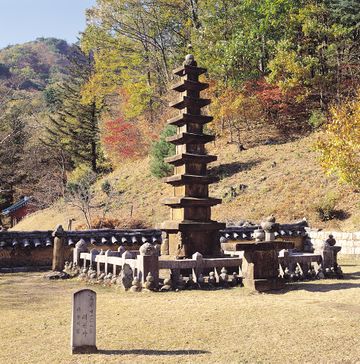산청 대원사 다층석탑
| 산청 대원사 다층석탑 Multi-story Stone Pagoda of Daewonsa Temple, Sancheong |
|
 산청 대원사 다층석탑, 국가문화유산포털, 문화재청. |
|
| 대표명칭 | 산청 대원사 다층석탑 |
|---|---|
| 영문명칭 | Multi-story Stone Pagoda of Daewonsa Temple, Sancheong |
| 한자 | 山淸 大源寺 多層石塔 |
| 주소 | 경상남도 산청군 삼장면 평촌유평로 453(대원사) |
| 지정(등록) 종목 | 보물 제1112호 |
| 지정(등록)일 | 1992년 1월 15일 |
| 분류 | 유적건조물/종교신앙/불교/탑 |
| 시대 | 조선시대 |
| 수량/면적 | 1기 |
| 웹사이트 | 산청 대원사 다층석탑, 국가문화유산포털, 문화재청. |
|
|
|
해설문
국문
산청 대원사 다층석탑은 신라 선덕여왕 15년(646)에 자장 율사가 부처님의 사리를 모시기 위해 세운 높이 5.5m의 탑이다. 임진왜란 때 파괴되었던 것을 조선 정조 8년(1784)에 다시 세웠다. 1989년에 해체하여 복원하는 과정에서 58과의 사리와 사리를 넣은 보관함이 발견되었다.
탑은 두 개의 바닥돌 위에 여덟 개의 지붕돌을 올린 구조이며, 꼭대기의 머리 장식은 일부만 남아 있다. 위층 바닥돌의 모서리에는 기둥 모양 대신 사람의 모습을 한 조각상이 새겨져 있으며, 네 면에는 사천왕*상이 새겨져 있다.
대원사 다층석탑은 조선 전기의 대표적인 석탑으로 조각은 소박한 편이나, 전체적으로 비율이 뛰어나고 탑의 각 부재가 완전하게 남아 있어 조선 시대 석탑을 연구하는데 귀중한 자료로 평가된다.
- 사천왕(四天王): 동서남북 사방을 보호하고 불교와 부처의 말씀을 수호하는 네 명의 신
영문
Multi-story Stone Pagoda of Daewonsa Temple, Sancheong
A pagoda is a symbolic monument enshrining the relics or remains of the Buddha. Although not all pagodas contain the true remains, they are nonetheless worshiped as sacred places that enshrine the Buddha.
It is said that this pagoda was originally built in 646 by Jajang, a Buddhist monk of the Silla period (57 BCE-935 CE) to enshrine the remains of the Buddha. It was destroyed during the Japanese invasions (1592-1598) and rebuilt in 1784. In 1989, when it was disassembled for renovations, a reliquary and 58 remains of the Buddha were found inside.
The pagoda is composed of a two-tiered base, eight sets of body and roof stones, and the remaining part of a decorative top. With its overall outstanding proportions and most of its parts remaining, it is an important resource for research on the pagodas of the Joseon period (1392-1910). Each side of the base is carved with one of the Four Guardian Kings who protects the dharma, i.e. the universal truth proclaimed by the Buddha, and at each corner is a depiction of a human figure. The roof stones are thick and unrefined, but each of their corners is curved slightly upward, creating a sense of buoyancy. Wind chimes are hung from each corner of the uppermost roof stone.
According to a local legend, when a celebratory national event occurred, the pagoda glowed and the temple was filled with a pleasant scent. It is also said that a clear-hearted person could see the remains of the Buddha enshrined inside the pagoda through its shadow reflected in the nearby pond.
영문 해설 내용
불탑은 부처의 유골을 모신 상징적인 조형물이다. 모든 탑이 진신사리를 모신 것은 아니지만, 부처를 모신 신성한 곳으로 여겨 신앙의 대상이 된다.
이 석탑은 원래 646년 신라의 승려 자장(590-658)이 부처님의 사리를 모시기 위해 세운 것으로 전해진다. 임진왜란 때 파괴되었던 것을 1784년에 다시 세웠다. 1989년 탑을 해체 복원하는 과정에서 58개의 부처님 사리와 사리장엄구가 발견되었다.
탑은 2단의 기단, 8층의 몸돌과 지붕돌, 머리장식 일부로 구성되어 있다. 전체적으로 비율이 뛰어나고 탑의 각 부재가 대체로 잘 남아있어 조선시대 석탑 연구에 귀중한 자료가 된다. 기단의 각 면에는 부처님의 가르침을 수호하는 사천왕을 새기고, 각 모서리에는 사람 모습을 한 조각상을 두었다. 지붕돌들은 두껍고 투박하지만, 각 모서리가 살짝 들려있어 가벼운 느낌을 준다. 8층 지붕돌의 각 모서리에는 풍경이 달려 있다.
전해지는 이야기에 따르면 나라에 기쁜 일이 있을 때 탑에서 빛이 나 환해지고 사찰 안에 좋은 향기가 가득했다고 한다. 또한, 마음이 맑은 사람은 근처 연못에 비친 탑의 그림자를 통해 탑 안에 모셔진 사리를 볼 수 있었다고 한다.